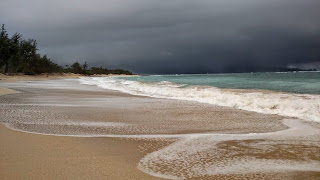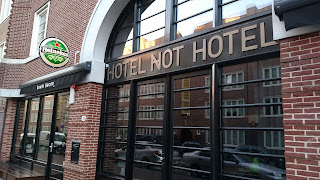The Celtic Tiger Roars Again?
***
Dublin is booming.
As the UK dithers in its denial of the Brexit trainwreck, international investment is flowing into Ireland at an unprecedented rate. And Dublin, being the capital, the largest city, and the premier college town of the Republic, is the main beneficiary. Like in Boston's Seaport District and San Francisco's Mission Bay, many of Dublin's new corporate edifices are popping up near her waterfront, in the "Docklands" neighborhood. On June 1st of last year, a reporter from The Irish Times had counted 70 cranes on the Dublin horizon (!). Some of the tech companies are familiar names like Trip Advisor, Survey Monkey, and Apple, but there are hundreds of homegrown Eire companies that are employing citizens and immigrants alike. The moniker to all this activity is Silicon Docks or Silicon Republic. And these companies must be doing something right; one study done by Indeed.com found that the happiest employees in all of Europe are in Ireland. It helps that Ireland is considered a low-tax haven for foreign multinational corporations. The republic is also considered the last pillar of the Anglo-sphere in the EU should the United Kingdom make good on its exit from the community (note: Malta, a former British company turned Republic, is also in the running).
So this, a working capital of excitement, was my main observation of Ireland's largest city. Dublin, having a smaller land mass and population, was truly San Francisco writ small, Fog City in a more concentrated dose. Dublin comes across still as precious. And the prices reflect that. There was also a tremendous amount of diversity on the streets: you shared the sidewalk with many Africans, Spanish, Eastern Europeans and Indians, many of whom have come to live in Dublin to work professionally and/or attend English school.
LUAS Tram, taken by Thomas Kilduff
It's not news that these tech and financial centers, like Boston, San Francisco and Dublin, are having a housing crisis. Every city council wants companies and workers but nobody wants to house them, or if they do, they are certainly having a hard time completing the task. While most municipalities see housing as controversial (think land use disputes, NIMBY's, permitting and building costs) and as a net drag on economies, for regular people housing is a necessity, the center for stable, happy lives––essential especially for the proper development of children. And while there are a ton of memes about the poor housing conditions and high rents in San Francisco, in Ireland it's even worse. Just yesterday, there was a concerted effort by housing activists demanding fair and reliable housing at major intersections in cities around the island. One such protest shut down O'Connell Bridge in the center of Dublin.
Yet, as a visitor and casual observer, there was a sense of excitement and openness in Dublin, the economy kicking on all cylinders. Of course all that economic activity has a dark side.
Phoenix Park Horizon, taken by Thomas Kilduff
Wild Deer in Phoenix Park, taken by Thomas Kilduff
This is not to say that the capital is all about capital, for Dublin still has its cultural charms. With its serpentine medieval layout and narrow sidewalks, the city feels intimate. Buskers on Grafton Street actually need to audition before city council to make sure they can entertain; only then are they given a permit card and number (evidently the poor quality of musicians had been a source of annoyance for residents and visitors alike). Dublin's tram service, LUAS, is sleek and quiet, proving once again that Europe has better technology in the public sphere. Each bridge over the River Liffey has a unique design and history. The parks, like Merrion Square and Saint Stephen's Green, are little gems with statues celebrating revolutionaries and writers.
Highlights
I know, I know: Mauricio and I travelled to Ireland for four days and mostly puttered around Dublin. Starting in Cork and driving up the "Wild Atlantic Way" will have to wait for the next trip, perhaps with my brother, when we would have a good week to spare (we've ancestors, and possibly relatives, in Cork, Sligo, and Donegal).
But as I've previously mentioned, Dublin is still peppered with charms. The highlights below include one new tourist destination and two beats that were independent and fantastic.
Neon Asian Street Food
We actually found this one from YELP. Neon Asian Street Food is one hot ticket; it's a new place that opened up along trendy Camden Street. It was packed with young people and offered delicious Thai and Vietnamese food at affordable prices. One cutesy touch is that they provide you with an empty waffle cone in which you can self-serve soft-serve ice cream at dinner's end.
My one nit-pick is that they serve everything in those white, cardboard Chinese take-out containers. While that's great if you suddenly want to bounce and eat your dinner at home, it seems entirely wasteful. Then again, recycling is widespread throughout the Republic, nearly on par with San Francisco.
Taken by YELP user
Gate Theatre
I scored tickets for us to see "The Snapper," Roddy Doyle's world-premiere theatrical comedy of the 2nd novel in his Barrytown Trilogy from the early 90's. "The Snapper" is a comedic take of one family's response to their eldest daughter getting pregnant, all in a working-class brogue and pot shot dialogue. This was our most authentic event of our Ireland trip. Everyone on stage and in the audience was Irish. There was a bar downstairs for pre-drinks and intermission drinks and a place upstairs for tea for the aunts and mothers.
Family Bonding Time, taken by Gate Theatre Photographer
"The Snapper" took place at the historic Gate Theater on Dublin's North Side. It featured lots of big, adolescent hair and an 80's pop soundtrack. Teen and pregnancy films like Heathers and Obvious Child were noticeable influences.
Girls Just Wanna Have Fun, taken by Gate Theatre Photographer
EPIC
EPIC (not an acronym as for as I could research) is the Irish Emigration Museum, a new showcase telling the story of the 10 million people who left Ireland. Let's face it: museums are certainly enjoyable but they can be mentally and physically exhausting. Part of the issue is that there is so much to take in for the brain; I've found that it's better to do museums in piecemeal, instead of cramming it all in. Truthfully, I only finished experiencing 75% of the Irish Emigration Museum's two dozen corridor-like room displays and I had little interest in the sports exhibits. But what stands out for EPIC is that it told a story. The cultural achievements of the Irish emigrants piggybacked their chronology. In other words, a museum-goer would start in room 4 detailing the suffering and desperation of the Irish during the potato famine in 1845 and end up in room 16 witnessing the musical craze of RiverDance and The Cranberries by the mid-1990's. Sports, Literature, Politics, Science: the Irish have much to be proud about in all their achievements, all sprung from this little island. It was all very thoughtful, interactive, and inspiring. Highly Recommended.
Descriptions of Emigrants, EPIC Museum, taken by Thomas Kilduff
***All Photos Taken by Mauricio Rojas Unless Otherwise Noted

















Comments
Post a Comment